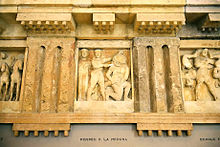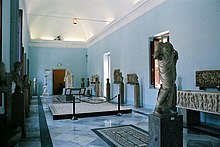Museo Archeologico Regionale Antonino Salinas
The Museo Archeologico Regionale Antonino Salinas in Palermo (Regional Archaeological Museum) shows a collection of archaeological finds mainly from the western part of Sicily from the prehistory of the island to the late Roman period.
building
The Regional Archaeological Museum is housed in the former monastery of the Congregation of St. Philip Neri . This complex of buildings, called Olivella, which also includes the church of S. Ignazio and the adjoining oratory, was started at the end of the 16th century according to a plan by Antonio Muttone. However, it was not completed until the 17th century. In 1866 it was converted into a museum. After severe damage in World War II , entire wings had to be rebuilt.
The exhibition rooms are grouped on three floors around two inner courtyards with arcades that previously served as the cloister of the monastery.
The collection of the Museo dell'Università, founded in 1814, forms the basis of the exhibition. The archaeologist Antonino Salinas (1841–1914) contributed greatly to the expansion of the collection through his intensive work. Hence the museum bears his name in his honor.
The museum's holdings initially grew through donations (especially from the Bourbon rulers) and through the acquisition of private collections. It was not until later that materials from systematic excavations (and in some cases from accidental finds) were added.
The museum also houses a specialized archaeological library.
Exhibits
Finds from Selinunte
Finds from Selinunte are exhibited in a separate hall . Above all, these are parts of the Doric friezes, which are characterized by a sequence of triglyphs and metopes .
The frieze fragment with three metopes shown on the right comes from Temple C (6th century BC). These metopes were recovered by two Englishmen in 1823. In 1827 four metopes from Temple E (5th century BC) were added.
Compared to older archaic metopes, which are also exhibited here, the transition from flat, more relief-like representations to a more realistic plastic representation can be seen in the metopes of Temple C.
While the figures on the metopes of Temple C are still shown frontally, the metopes of the more recent Temple E show only side representations. Here male and female figures stand opposite each other, the bodies of the female figures being made of a lighter material.
A reconstruction of the clay tympanum decorations from Temple C.
There are also parts of Temple B from the 4th century BC. BC whose traces of color shook the classic image of the pure white temple.
Bronze collection
A separate hall is dedicated to Greek bronze figures.
Probably the most impressive sculpture is a bronze ram from Syracuse (4th century BC). It probably comes from the school of Lysippus and shows a very lively representation. The lying ram has its head raised and turned to one side, and a loose flaky fur covers the body. Together with a second ram he adorned the main portal of the Castello Maniace in Syracuse . The second copy was destroyed during the revolution of 1848.
Another impressive sculpture is the bronze statue of Hercules wrestling with a stag.
In addition, numerous small sculptures are exhibited in the showcases, such as those of Melqart from Sciacca .
Other exhibits
- prehistoric finds, etc. a. a copy of the cave paintings of the Cave of Addaura and prehistoric ceramics
- Underwater archeology (anchors and finds from sunken ships)
- the Palermostein , a stone slab on which the annals of the first 5 dynasties of the Egyptian old empire are written on both sides with hieroglyphics
- male torso from Mozia , one of the finest examples of Punic art
- Phoenician and Carthaginian anthropomorphic sarcophagi
- Punic grave stelae in the shape of a megaron with painted banquet scenes of the deceased
- Lions head gargoyles of the Temple of Himera
- one of the largest Etruscan collections outside of Tuscany , mainly grave steles, sarcophagi and urns made of Chiusi and Etruscan Bucchero ceramics
- Roman mosaics and sarcophagi
literature
- Brigit Carnabuci: Sicily. Greek temples, Roman villas, Norman cathedrals and baroque cities in the center of the Mediterranean (= DuMont art travel guide ). 6th, updated edition. DuMont Reiseverlag, Ostfildern 2011, ISBN 978-3-7701-4385-6 .
Web links
- Archaeological Museum , Chr. Bühler, Landeskunde online 2002/04
Coordinates: 38 ° 7 ′ 15.2 " N , 13 ° 21 ′ 37.3" E




